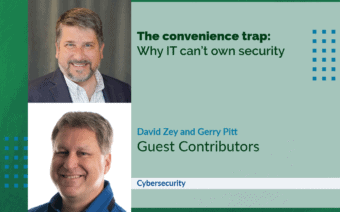
November 18, 2024
Cybersecurity is a scary word for many – conjuring images of faceless hackers, data breaches and spiraling costs.
Yet, it’s an essential part of every business’s survival and growth strategy.
In today’s digital landscape, protecting sensitive data, ensuring operational continuity and maintaining customer trust have never been more critical.
The stakes are high, but so are the rewards for those who approach cybersecurity with diligence and foresight.
This column explores threats from both outside and inside your organization, offers strategies for mitigation and explains why cybersecurity insurance is a crucial safety net in today’s high-risk environment.
Why cybersecurity is essential to your business
Protection of sensitive data
Your business handles a variety of sensitive information, from customer data to proprietary secrets.
A breach can result in not only financial loss but also legal consequences if compliance requirements (like GDPR, HIPAA or CCPA) are not met.
Safeguarding this data is crucial for maintaining your competitive edge and avoiding hefty fines.
Preventing financial loss
The cost of a cyberattack can be staggering.
From ransomware payments to the expense of restoring compromised systems, even a single incident can put a significant dent in your budget.
Cybersecurity insurance helps mitigate these costs, but strong preventive measures – like firewalls, intrusion detection systems and regular system updates – can often stop attacks before they begin.
Maintaining customer trust
Customers trust you with their data, and that trust is hard-earned but easily lost.
A data breach can tarnish your reputation and send clients running to competitors.
By demonstrating a robust commitment to cybersecurity, you reassure customers that their information is in safe hands, which fosters loyalty and strengthens your brand.
Operational continuity
Downtime is costly.
Whether it’s a ransomware attack locking you out of critical systems or a DDoS attack crippling your website, operational disruptions can grind your business to a halt.
Effective cybersecurity measures and disaster recovery plans ensure minimal downtime and quick recovery, helping you maintain continuity even during an attack.
Staying ahead of potential threats
The cybersecurity landscape evolves rapidly, with new threats emerging every day.
Staying ahead means more than just reacting to attacks – it requires proactively identifying and addressing vulnerabilities.
Regular security assessments, patch management and leveraging the latest threat intelligence keep you one step ahead of bad actors.
Empowering employees
Your employees are your first line of defense.
Cybersecurity is not just an IT problem – it’s a company-wide responsibility.
By investing in awareness training, you empower your team to recognize phishing attempts, avoid risky behavior and adopt secure practices.
This not only reduces risk but also fosters a culture of vigilance and accountability.
Types of cybersecurity attacks
External threats
External attacks come from adversaries outside your organization, aiming to breach your defenses and exploit your systems.
Some of the most notorious types, include:
- Ransomware attacks: These malicious programs encrypt your data, holding it hostage until a ransom is paid. The Colonial Pipeline attack in 2021 is a stark reminder of the potential impact, with operations halted and millions paid in ransom.
- Supply chain attacks: These attacks compromise a trusted vendor or software provider to infiltrate your organization. The SolarWinds attack of 2020-21 demonstrated the devastating ripple effect of such breaches.
- Zero-day exploits: These take advantage of vulnerabilities in software that are unknown to the vendor. For instance, the Log4j vulnerability in 2021 left thousands of systems exposed before a patch was released.
- DDoS attacks: Distributed Denial of Service attacks overwhelm your systems, rendering them inoperable. They may not steal data, but they can cripple your operations.
Internal threats
Though external threats often get the most attention, internal risks can be equally damaging, including:
- Insider threats: Malicious employees or contractors with access to sensitive information can cause intentional harm.
- Accidental data exposure: Mistakes, such as emailing sensitive information to the wrong person, can lead to significant data leaks.
- Phishing and social engineering: These tactics trick employees into providing access to systems. Once inside, attackers can escalate their privileges to inflict more damage.
Mitigating cybersecurity risks
Building walls and digging moats: External defenses
Protecting against external threats requires a strong perimeter defense – this includes firewalls, intrusion detection systems and endpoint protection.
However, these defenses must evolve continuously to address emerging threats.
Empowering employees: Internal security
The weakest link in cybersecurity is often human error.
Training employees to recognize phishing attempts and understand social engineering tactics is crucial.
Regular security awareness training can turn your staff into your first line of defense rather than a vulnerability.
Encourage a culture of cybersecurity by:
- Hosting regular training sessions
- Conducting simulated phishing attacks
- Empowering employees to report suspicious activity without fear of retribution
Partnering with experts: External cybersecurity support
Engaging an external cybersecurity vendor can provide access to the latest tools and expertise. Regular reviews of monitoring data and annual vulnerability assessments can keep your defenses sharp.
Fortifying your infrastructure
Basic security hygiene can prevent many attacks
- Use complex passwords and enable multi-factor authentication (MFA)
- Regularly update software and firmware
- Deploy network monitoring tools to detect anomalies
The role of cybersecurity insurance
Even with the best defenses, no system is entirely immune to cyberattacks.
That’s where cybersecurity insurance comes in, offering a financial safety net.
First-party cyber insurance
This coverage protects your business from direct losses due to cyber incidents.
It typically covers:
- Data breach recovery costs
- Business interruption losses
- Ransomware payments
- Customer notification and regulatory compliance costs
However, to qualify, your business must often meet specific security criteria, such as implementing MFA and endpoint detection and response (EDR) solutions.
Third-party cyber insurance
This protects against claims or lawsuits from external parties affected by a breach involving your company.
It covers:
- Liability for customer or partner data breaches
- Legal defense costs
- Regulatory fines and penalties
- Contractual breaches related to data security obligations
Conclusion: Daily cybersecurity habits
Cybersecurity is like brushing your teeth – it’s not always fun, but you need to do it daily.
It’s about cleaning the surface and getting between the gaps to prevent damage.
And if a toothache strikes, you’ll be glad you have good insurance and a trusted dentist in place.
In the same way, businesses must commit to daily cybersecurity practices, from employee training to system updates.
And when an incident inevitably occurs, having the right insurance and trusted partners will make all the difference.
 It’s official: Rice Lake ‘is on the map’
It’s official: Rice Lake ‘is on the map’ Green Bay Public Market expected to fall short of 2025 NFL Draft deadline
Green Bay Public Market expected to fall short of 2025 NFL Draft deadline







